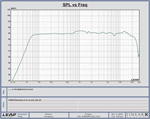Question:
I have a Velodyne CHT-10 subwoofer connected to my Denon receiver’s pre-out. I love it very much except for one thing—it sometimes sounds boomy. Do you know what could cause that and whether or not there’s a setting I could change to make it always sound crisp?
– George P.
Mississauga, Ontario
Canada
Answer:
Boomy bass is most often due to the placement of the subwoofer and your seating position. All rooms reinforce certain low frequencies at certain locations, which are called peaks, while other frequencies are canceled out at other locations called nulls, depending on the dimensions of the room.
This occurs because sound waves reflect from the walls, ceiling, and floor of the room, and certain frequencies have wavelengths that are simple multiples or fractions of the room’s dimensions—for example, the wavelength of a certain frequency might be equal to the room’s width, while the wavelength of another frequency might be half or a third of the room’s length. At these frequencies, the crests and troughs of the reflected sound waves reinforce or cancel each other at certain stationary points in the room. These waves are called standing waves, and the frequencies at which they occur are called room modes.
You can’t eliminate standing waves entirely, but you can mitigate them to some degree by optimizing your seating position and subwoofer location. The best approach is to have your room’s acoustics analyzed by a trained professional, which will reveal the best locations for your seats and sub. You can also install acoustic treatments designed specifically for your room based on the analysis. However, the analysis and treatments can be very expensive.
Here are a couple of general tips. If at all possible, don’t place your seats up against a wall, because low frequencies tend to build up at wall boundaries, as illustrated in the diagram above. As you can also see in the diagram, the exact center of the room in any dimension is generally not advised, because it usually coincides with a peak or null.
It is very difficult to achieve smooth bass performance from a single sub in any location, especially for more than one seat. Placing two subs at the halfway points along opposite walls of a rectangular room achieves better results for more than one seat, and four subs at the halfway points or in the corners of a rectangular room is best of all.
Of course, not all rooms are rectangular, and in any event, there’s a way to find the best location for the sub in your room. It’s called “the subwoofer crawl.” Start by putting the subwoofer in your listening seat—that’s right, in the seat, not on the floor. Then, play a familiar, bass-heavy audio track, preferably without the main speakers. (Make sure the main speakers are set to “small” in your AV receiver so the low frequencies are routed to the subwoofer output.)
You can also play a low-frequency test tone, such as the last chapter in the Audio section of THX Optimizer, which is included on most THX-certified DVDs and Blu-rays. (Click here for a list of THX-certified titles.) This chapter plays a frequency sweep from 200Hz down to 20Hz. White or pink noise, which can be found on many audio test discs, will also work. If your receiver lets you play its internal test signals manually, you can select the subwoofer signal.
Whichever track you select, set it to repeat so it plays over and over. Then, crawl around the room—especially along the walls, since you probably don’t want the sub to be in the middle of the room—with your head near the floor and listen to the sound. As you move around, you’ll hear different frequencies become more or less emphasized; you’re looking for the spot at which all low frequencies are well-balanced with none being overly pronounced or missing. That’s the spot to place the sub, which should minimize its boominess at the listening position.
What about equalization? Wouldn’t that help? Not as much as you might think. First of all, you’d need a fairly sophisticated equalizer—more sophisticated than what is found in most AV receivers—which can be expensive. And while you can reduce the level of the peak frequencies, you can’t increase the level of the nulls, since the standing waves cancel out at those locations no matter what the level is. Also, reducing the level of a peak helps in its specific location, but it weakens that frequency at other locations, worsening the sound for the people sitting there.



